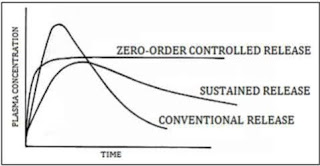Pharmaceutical Solution
Solution:
Solutions are easier to
swallow than solids & are therefore particularly acceptable for pediatric
(child) & geriatric (old) use.
2. Rapid absorption:
The drug must be in
solution before it can absorb. Solutions are absorbed rapidly as it does not
require to go into further solution.
3. Rapid onset of
action:
Therapeutic response is
faster of a solution than solids for rapid absorption specially for external
purposes.
4. Dose uniformity:
As solution is a homogenous mixture & therefore the drug will be uniformly distributed throughout the preparation & accurate dose can be obtained from it.
5. Reduction of irritation by drug:
Gastric irritation can be reduced by administration of a drug in solution dosage form because of the immediate dilution of gastric content.
6. Palatability:
Solution can easily be flavored, sweetened & colored which make it more palatable.
Disadvantages of Liquid Dosage Forms:
1.Large space:
Huge space is required for liquid having large volume.
2. Break down of container:
There is a chance of breakage of the bottle.
3. Transport & storage:
Liquid are bulky & therefore inconvenient to transport & storage.
4. Chance of microbial growth:
Solution often provide suitable media for the growth of microorganisms & may therefore require the incorporation of a preservative.
5. Date of expiry:
In case of liquid dosage form expiry date is very less in comparison to that of solids.
Types of Solution
A pharmaceutically formulated solution may be following types –
1. Mixture & draughts
2. Elixirs
3. Linctuses
4. Mouthwash & gargles
5. Nasal products
6. Ear/Eye drops
7. Enemas
8. Preparation for external uses
9. Intermediate products
Mixtures are usually aqueous preparations which can be in the form of either a solution or a suspension. Most of preparation of this types are manufactured on a small scale as required & are allocated a shelf life of few weeks before dispensing. Doses are usually given in multiples of 5 ml using a metric medicine spoon.
A draught is a mixture of which only one or two large doses of about 50 ml are given, although smaller doses are often necessary for children.
n2. Elixirs:
The term mixture &
elixir are often confused although an elixir refers strictly to a solution of a
potent or nauseous drug.
If the active agent is
sensitive to moisture it may be formulated as a powder or granulation by the
pharmaceutical industry & then simply dissolved in water immediately prior
to administration.
Dosage is usually given
using a 5 ml medicine spoon although smaller volumes can be given using a
volumetric dropper.
n3. Linctuses:
A linctus is
a viscous preparation usually
prescribed for the relief of cough. It usually consist of a simple solution of
the active agent in a high concentration of sucrose often with other sweetening
agents.
This type of product,
which is also designed to be administered in multiples of 5 ml, should be
sipped slowly & not be diluted beforehand. The syrup content has a
demulcent action on the mucous membrane of the throat.
For diabetic use sucrose
is usually replaced by sorbitol and/or synthetic sweeteners.
Aqueous solution for the prevention of mouth & throat infections can contain antiseptics, analgesics and/or astringents.
They are usually diluted with warm water before use.
These are formulated as small volume solutions in an aqueous vehicle, oil being no longer use for nasal administration.
Because of buffering capacity of nasal mucous is low, formulation at a pH of 6.8 is necessary. Nasal drops should also be make isotonic with nasal secretions using sodium chloride & viscosity can also be modified using cellulose derivatives if necessary.
Active agents for administration by this route are usually for local use & include antibiotics, anti-inflammatories & decongestants.
These are simple sterile solutions of drugs in either water, glycerol, propylene glycol or alcohol/water mixtures for local use & include antibiotics, anti-inflammatories & decongestants.
Aqueous or oily solutions, as well as emulsions & suspensions, are available for the rectal administration of medicaments for cleansing, diagnostic or therapeutic reasons.
Lotions can be formulated as solutions & are design to be applied to the skin without friction.
They may contain either humectants, so that moisture is retained on the skin after application of the product, or alcohol which evaporates quickly, impairing a cooling effect & leaving the skin dry.
Liniments, however, are intended for massage into the skin & can contain such
ingredients as methyl salicylate or camphor as counter-irritants.
Paints
are liquid for application to the skin or mucous membrane where the solvent evaporate quickly leaving a film on the skin containing the active agent
& the viscosity modifier such as glycerol to ensure prolong contact with
the skin.
Collodions are similar preparations which, after evaporation of the solvent, leave a tough, flexible film which will seal small cuts or holes a drug in intimate contact with the skin.
The film former is usually pyroxylene (nitrocellulose) in an alcohol/ether or alcohol/acetone solvent blend. Often a plasticizer such as castor oil & an adherent like colophony resin are included in this preparation.
n9. Intermediate
products:
There are many
pharmaceutical solutions which are design for use during the manufacture of
other preparations & which are rarely administered themselves. Examples are-
Aromatic water~ It
is an aqueous solution of volatile oil materials which are used mainly for
their flavoring properties. Examples include peppermint water & anise water
which also have carminative properties and chloroform water also acts as a
preservative.
They are usually
manufactured as concentrated water & are then diluted traditionally 1 to 40
in the final preparation.
Infusions extracts & tincture are terms used for concentrated solutions of
active principles from animal or vegetable sources.
Infusions are prepared by extracting the drug using
25% alcohol but without the application of heat. Traditionally this preparation
are then diluted 1 to 10 in the final product.
Extracts are
similar products which are then concentrated by evaporation.
Tinctures are alcoholic extracts of drug but are
relatively weak compared with extracts.
Spirits
are also alcoholic solutions
but of volatile materials which are mainly used as flavoring agents.
Syrup are concentrated solutions
of sucrose or other sugars to which medicaments or
flavorings are often added.
Although syrup are used in the manufacture of
other preparations, such as mixtures or elixirs, they can also be administered
as products in their own right, the high concentration of sugar imparting a
sweetening effect.
Formulation of a Liquid Dosage Form
1. water
2. an aromatic water
3. active ingredients/medicaments
B. Adjuvants (excipients/formulation additives) -
1. Chemical stabilizer (antioxidants)
2. Buffer/buffering agent
3. Viscosity modifier
4. Isotonicity modifier
5. Coloring agent
6. Sweetening agent
7. Flavoring agent
8. Preservatives (antimicrobial agent)
9. Density modifier
Formulation of solution
A.
Vehicle:
Water is the solvent most widely used as vehicle
for pharmaceutical products because of the various properties-
nIt
is non-toxic
nNonirritant
nWidely
available
nTasteless
nEasy
to store
nPhysiologically
compatible to the body
nA
wide range of materials dissolve in water
nIts
purity is constant
nLack
of pharmacological activity
nHigh
dielectric constant
B. Adjuvents/Formulation Additives:
i. Chemical stabilizer (antioxidants/reducing agent):
npH
adjustment drug formulation with body should be considered in order to avoid
incompatibility/irritation to the body system & this is done with the help
of buffering agents. Most pharmaceutically acceptable buffering systems are
based on carbonates, citrates, gluconates, lactates, phosphates or tartarates.
nAs
the pH of the most body fluid is 7.4, products such as injections, eye drops
& nasal drop should be buffered at this value to avoid irritation.
iii. Viscosity Modifier:
Solutions for injections, for application to mucous membranes, ophthalmic must be iso-osmotic with tissue fluid to avoid irritation & pain.
To adjust the isotonicity, isotonicity modifiers are added such as dextrose, NaCl.
iv. Coloring agent:
Coloring agents are also
used in order to improve the attractiveness of the product & also to
distinguish or differentiate various products including poisonous drugs,
antiseptics etc.
Some natural coloring agents include carotinoids, chlorophyll, anthocyanins, riboflavines, caramel & extract of beetroot.
v. Sweetening agent:
nTo
mask the salty or bitter taste of the drugs, sweetening agents are used in
large extent.
n
Sucrose is the most widely used sweetening agent.
nArtificial
sweeteners include- sodium saccharine, calcium saccharine, aspartame, sodium
cyclamate.
vi. Flavoring agent:
Flavoring agents can be
used to render a product palatable having unpleasant taste.
This is particularly useful in pediatric formulation. Flavoring
agents can be obtained from natural as well as artificial sources.
Natural flavoring agents include fruit juice, aromatic oils such as
peppermint & lemon oil, herbs & spices & distilled fraction of
these.
vii. Preservatives (antimicrobial agents):
nWhen
choosing a suitable preservatives it must be ensured that absorption from
preservatives onto the container from the product does not occur.
nIts
efficiency is not impaired by the pH of the solution or by interaction with
other ingredients.
nExamples
include: Na-benzoate, PABA ester etc.
viii. Density modifier:
Density modifiers are
used only in formulating spinal anesthetics.
Solutions having density equal to CSF are called isobaric.
Careful control of both of the density of the injection will enable
precise control of the area to be anaesthetized.
Example- dextrose.
Formula of some common solutions:
PARACETAMOL ORAL SOLUTION BP: 120mg/100ml
1. Glycerine- i. co-solvent
ii. viscosity imparting
agent
iii. polishing effect
2. Propylene glycol- main co-solvent
3. Methyl PARABEN Na- used as antimicrobial
preservatives
4. Propyl PARABEN Na- used as antimicrobial
preservatives
5. Sucrose syrup- sweetner
6. Citric acid- antioxidant
7. Color
8. Flavor
9. Water q.s. to 100ml
Differences between Solution, Colloid & Suspension
|
Parameters |
Solution |
Colloid |
Suspension |
|
System |
Homogenous system |
Heterogeneous system |
Heterogeneous system |
|
Particle size |
Less than 1 nm |
Lies between 1nm-0.5 mm |
More than 0.5 mm |
|
Passage through filter paper |
Particle can easily pass through filter paper |
Can pass slowly through filter paper |
Can not pass through filter paper |
|
Parameters |
Solution |
Colloid |
Suspension |
|
Ability to scatter light |
Particle can not scatter light |
Particle can scatter light |
Particle can scatter light |
|
Passage through semi permeable membrane |
Easily pass through semi permeable membrane |
Not pass through semi permeable membrane |
Not pass through semi permeable membrane |
|
Parameters |
Solution |
Colloid |
Suspension |
|
Brownian movement |
Does not show Brownian movement |
Shows Brownian movement |
Shows Brownian movement |
|
Colligative property |
Exhibit colligative properties |
Exhibit one of the colligative properties |
Does not exhibit colligative properties |
|
Parameters |
Solution |
Colloid |
Suspension |
|
Visibility in electron microscope |
Invisible |
Visible |
Visible |
|
Diffusion |
Undergo rapid diffusion |
Diffuse very slowly |
Does not diffuse |
|
Phase |
One phase system |
Usually two phase system may be~ S-L, L-S,G-S |
Two phase system may be~ L-L (emulsion), S-L (suspension) |



Comments
Post a Comment
Thanks